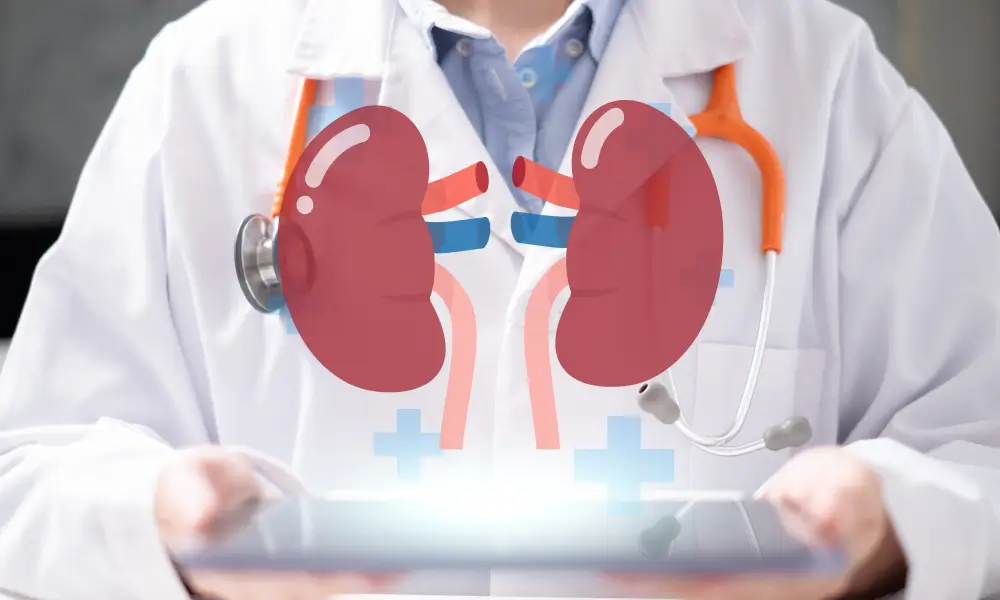What to Do If a Kidney Transplant Fails: A Guide for Patients

TABLE OF CONTENTS
- Kidney Transplant Failure: Understanding the Signs
- Why Do Kidney Transplants Fail? Common Causes
- What Happens Next? Immediate Steps After Failure
- Coping Emotionally & Physically After Transplant Failure
- Treatment Options: Managing Kidney Function Post-failure
- Dialysis vs. Second Transplant: What’s the Best Choice?
- Conclusion
- FAQs
Kidney transplant rejection affects 15% to 20% of recipients, creating significant uncertainty for patients who have already endured complex medical journeys. The impact of transplant failure extends far beyond the immediate medical concerns, as patients with failed grafts face mortality rates more than three times higher than those with functioning transplants.
However, there is hope. Retransplantation has shown remarkable success, offering an 88% reduction in mortality compared to remaining on dialysis. This comprehensive guide addresses the crucial steps patients should take if their kidney transplant fails, providing clear, actionable information about available options and future treatments.
Kidney Transplant Failure: Understanding the Signs
Recognising the signs of kidney transplant failure stands as a crucial aspect of post-transplant care. While blood tests during regular clinic visits often detect early signs of rejection, patients should remain vigilant about specific symptoms that might indicate potential complications.
Physical symptoms that warrant immediate medical attention include:
Temperature rising above 38°C accompanied by shivering
Severe headaches or new chest pain
Changes in urination patterns or reduced urine output
Unexplained fatigue or general feeling of being unwell
Swelling or tenderness near the transplant site
Significant changes in blood pressure
Acute rejection typically occurs within the first 12 months after transplantation, although rejection remains possible even years later. The medical team might notice delayed graft function, characterised by the kidney being 'sleepy' or slow to 'wake up', shown through elevated creatinine levels in blood tests.
Infections pose another significant concern for transplant recipients. The immunosuppressant medications necessary for preventing organ rejection simultaneously lower the body's natural defence mechanisms. Chest and urinary tract infections rank among the most frequent complications, though serious infections rarely occur.
The presence of these signs does not automatically indicate transplant failure. About 15% to 20% of kidney recipients experience some form of rejection. Most cases, particularly when caught early, respond well to adjustments in medication. Doctors can usually identify and treat rejection before any major or permanent damage occurs.
Why Do Kidney Transplants Fail? Common Causes

Kidney transplant failures stem from various medical complications, ranging from immediate post-surgical issues to long-term challenges. Studies indicate that about 64% of transplant failures occur due to rejection.
Blood clots pose an immediate risk after surgery, potentially blocking blood flow to the transplanted kidney. Similarly, fluid accumulation around the kidney creates damaging pressure that requires swift medical intervention.
Post-surgical infections, unless detected early, can cause permanent kidney damage.
Chronic rejection stands as the primary reason for transplant failure. This occurs through gradual damage by the body's immune system. Research shows that antibody-mediated rejection appears in nearly all cases of rejection-related failures.
Medication adherence plays a vital role in transplant success. Missing doses or stopping anti-rejection medicines altogether allows the body to recognise the donor kidney as foreign, triggering an immune response. Studies reveal that 47% of rejection cases involve patients who did not follow their prescribed medication regimen.
Several other factors contribute to transplant failure:
Recurrent disease - The original condition that damaged the native kidneys can return
Donor kidney complications - Sometimes unforeseen issues with the donor organ emerge
Medicine side effects - Certain medications might harm kidney function
Polyomavirus nephropathy - Accounts for 7% of transplant failures
Glomerulonephritis - Responsible for 18% of cases
Regular monitoring through blood tests and clinic visits enables doctors to detect potential issues early. This proactive approach, combined with proper medication adherence, significantly improves long-term transplant outcomes.
What Happens Next? Immediate Steps After Failure
Upon discovering kidney transplant failure, medical teams spring into action with a structured approach. Three critical decisions shape the immediate response: when to restart dialysis, how to manage immunosuppression medications, and whether surgical removal of the failed kidney becomes necessary.
The first priority remains preserving kidney function. Most rejection episodes respond well to treatment adjustments, allowing the transplanted kidney to continue functioning. Medical teams typically modify immunosuppressant prescriptions and might recommend brief hospital stays.
For transplants that have functioned beyond one to two years, doctors often recommend keeping the non-functioning kidney in place. Still, specific circumstances demand surgical removal, particularly in cases of:
Primary non-function
Blood vessel blockages
Early severe rejection
Hyperacute rejection
Managing immunosuppression presents unique challenges. Maintaining low-dose immunosuppression offers several benefits:
Preserves remaining kidney function
Prevents graft intolerance syndrome
Minimises immune system reactions
Helps avoid acute rejection
Monitoring becomes more intensive during this period. Doctors observe for infections since immunosuppressant medications weaken the immune system. Regular blood tests and clinical assessments help track recovery progress and medication effectiveness.
For long-term planning, patients face two primary options: returning to dialysis or pursuing another transplant. The choice depends on individual health factors and circumstances. Many patients qualify for subsequent transplants if they maintain suitable health status.
The medical team tailors treatment plans based on several factors:
Type of rejection
Severity of tissue damage
Overall health status
Presence of other medical conditions
Throughout this challenging period, maintaining close communication with doctors remains crucial. Any new symptoms or health changes warrant immediate medical attention, ensuring prompt intervention when needed.
Coping Emotionally & Physically After Transplant Failure
The emotional journey after kidney transplant failure often proves as challenging as the physical recovery. Studies reveal that 20-40% of patients experience confusional psychosis with anxiety, restlessness, and emotional instability in the immediate post-failure period.
Physical recovery demands careful attention to specific guidelines. Doctors recommend:
Staying well-hydrated with 2 litres of water daily
Avoiding raw or undercooked foods
Including protein-rich foods to aid muscle recovery
Steering clear of grapefruit and certain herbal supplements
Abstaining from non-steroidal anti-inflammatory drugs
The psychological impact manifests differently across patients. Some experience liberation feelings and intense emotionalism, whereas others face anxious-depressive states. The adaptation process typically spans six months to a year, marked by various emotional phases.
Support systems play a vital role throughout recovery. Transplant centres offer counselling services and access to psychologists specifically trained in transplant-related emotional support. Furthermore, many patients benefit from joining transplant peer mentor programs and sharing experiences with others facing similar challenges.
The medical team closely monitors recovery progress through regular follow-up visits. Initially, patients might need appointments 1-2 times weekly, gradually decreasing frequency over time. For those living far from transplant centres, telehealth options often prove beneficial.
Regular communication about emotional well-being proves equally essential as physical health monitoring, enabling timely interventions and support.
Treatment Options: Managing Kidney Function Post-failure
Managing a failed kidney transplant requires careful consideration of treatment options. Studies show that patients returning to dialysis after transplant failure face survival rates below 40% within 10 years of dialysis reinitiation. Consequently, healthcare teams focus on tailoring treatment approaches based on individual patient circumstances.
Pre-emptive retransplantation emerges as the most effective option. It offers superior outcomes by avoiding the complications associated with dialysis reinitiation.
In the case of dialysis, the choice between peritoneal dialysis (PD) and haemodialysis (HD) remains subject to debate. Patients planning for retransplantation, especially from living donors, often benefit from PD treatment. This approach shows improved outcomes during the early period after graft failure.
Immunosuppression management presents unique challenges. Research suggests that maintaining low-dose immunosuppression might benefit patients returning to peritoneal dialysis, potentially extending life expectancy by 5.8 years versus 5.3 years with complete withdrawal.
Cardiovascular diseases remain the leading cause of death among patients returning to dialysis, accounting for 36% of cases. Additionally, sepsis-related deaths occur more frequently during this period, representing 17% of mortality cases. Therefore, treatment plans must address immediate transplant-related concerns and long-term health implications.
Dialysis vs. Second Transplant: What’s the Best Choice?
Second transplants offer remarkable survival advantages compared to long-term dialysis. Research demonstrates an 88% reduction in mortality rates among patients who undergo retransplantation versus those who remain on dialysis.
Patients opting for second transplants face unique considerations. The success rates vary based on several factors:
Time between transplants - Longer intervals show better outcomes
Age at retransplantation - Younger patients demonstrate higher success rates
Overall health status - Fewer comorbidities improve survival chances
Previous transplant duration - Longer survival of the first transplant predicts better outcomes
Antibody levels - Lower antibody levels increase success probability
Retransplantation presents distinct advantages. Studies reveal five-year survival rates of 87% for second transplants, surpassing the 72% rate observed with first transplants. This improvement stems from advanced surgical techniques and enhanced immunosuppression protocols.
However, dialysis remains crucial for many patients. Some might require temporary dialysis while awaiting a suitable donor. Others might choose long-term dialysis based on medical recommendations or personal preferences.
The decision between dialysis and retransplantation hinges on multiple considerations:
Medical factors:
Cardiovascular health status
Presence of diabetes
Previous surgical complications
Current antibody levels
Overall physical condition
Personal considerations:
Quality of life preferences
Support system availability
Distance from treatment centres
Work commitments
Financial resources
Healthcare teams assess each case individually, weighing various factors. Remarkably, advances in transplant medicine continue to improve success rates. Modern immunosuppression protocols have decreased rejection rates by 40% compared to earlier decades. Additionally, enhanced surgical techniques have reduced operative complications. These improvements make second transplants increasingly viable options for suitable candidates.
Conclusion
Kidney transplant failure presents significant challenges, though medical advances offer hope for patients facing this situation. Second transplants show remarkable success rates, reducing mortality risk by 88% compared to remaining on dialysis. Modern surgical techniques and better immunosuppression medications have decreased rejection rates by 40%.
The path forward depends on each patient's unique circumstances. Medical teams consider medical factors, personal preferences, and available support systems when recommending treatment options. Above all, early detection and swift action remain essential for positive outcomes.
The medical community continues making progress in transplant medicine. Success rates keep improving, offering renewed hope for patients needing second transplants. With proper medical care, support, and dedication to treatment plans, many patients overcome transplant failure and return to healthy, active lives.
FAQs
What exactly happens during kidney rejection?
Rejection occurs when the immune system identifies the transplanted kidney as foreign and attempts to fight it. The body's natural defence mechanism, designed to protect against harmful substances, mistakenly targets the new kidney. Immunosuppressant medicines play a vital role in preventing this response.
Can rejection be treated successfully?
Most rejection cases respond positively to treatment adjustments. Medical teams typically modify immunosuppressant dosages to higher levels. Treatment success depends on rejection severity, often requiring brief hospital stays spanning 3-5 days.
What signs indicate possible rejection?
Physical symptoms warranting immediate medical attention include:
Fever above 38°C with shivering
Reduced urine output
Swelling near the transplant site
Unexplained fatigue
Changes in blood pressure
Should patients return to dialysis after transplant failure?
Upon kidney failure, dialysis becomes necessary for survival. Remarkably, patients can pursue another transplant if they meet health requirements.
What role does medication adherence play?
Taking immunosuppressant medicines precisely as prescribed proves crucial. Missing doses or irregular medication schedules can lead to insufficient blood levels, potentially triggering rejection.
How does the evaluation process work for retransplantation?
Medical teams conduct comprehensive assessments, examining:
Current health status
Previous transplant history
Medication compliance records
Support system availability






